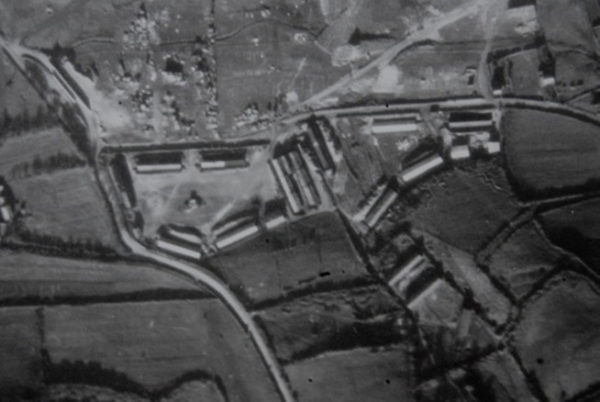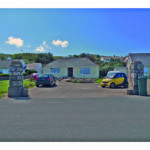Helgoland
- Country: Alderney, The Channel Islands
- GPS: 49° 43' 8.3388 N, -2° 12' 46.7388 W,
- Address: Off La Route de Picaterre and Le Petit Val
- Operational: 31/12/1941 - 01/04/1942
By Caroline Sturdy Colls and Kevin Colls
Dates Active:
Helgoland was constructed sometime between December 1941 and April 1942. The camp was still functioning at least until April 1944, although reductions in prisoner numbers were made before this time.1 When the British military arrived in May 1945, the huts had long been demolished.2
In the north-west corner of Alderney, the Germans built a camp called Helgoland which would ultimately become the second largest Organisation Todt (OT) labour camp on the island. Witness testimonies confirm that the first inmates were Dutchmen, Frenchmen and Frenchwomen followed by workers from Soviet territories collectively labelled as ‘Russian’ (but actually coming from Ukraine, Poland, Russia and other Eastern European countries).3 Workers from Helgoland were primarily employed in construction and cement works at the nearby forts of Platte Saline and Tourgis and most worked for the Kniffler and Deubau firms throughout the occupation.4
Aerial photographic analysis during recent archaeological investigations have demonstrated that from mid-May 1942, the camp initially consisted of a complex of fourteen wooden barracks that was expanded to the south-east by July 1942, undoubtedly, to accommodate the influx of Eastern European workers that occurred at this time.5 When the camp was at its largest, twenty-two buildings existed with a capacity of 1,500 inmates.6 7
The first Commandant of Helgoland was OT Obertruppführer Bäcker, who was described as a drunk by Alderney resident Robert Oselton.8 He was succeeded by OT Haupttruppführer Johann Hoffmann who appears to have taken over in January 1943 following a camp inspection.9 ‘Russian’ Kapos (prisoner guards) also operated in Helgoland, helping the German administration keep control of the inmates.10 According to Hoffmann, Helgoland had no fence, which supposedly made it easier for men to come and go, and made it difficult for the camp administration to keep track of the number of inmates.11 However, Georgi Kondakov – who spent 14 months in Helgoland – recalls how he cut the barbed wire around the camp to escape to a nearby piggery to acquire food, suggesting that some sort of boundary must have existed and this is confirmed by aerial photographs.12
Ill-treatment and violence were commonplace in Helgoland throughout all periods of its operation, although it is possible to identify several phases aligned to the two separate Camp Commandants, and before and after an inspection of the camp in the winter of 1942/1943.13 Under Bäcker, the Frenchmen, Dutchmen and women housed in the camp in its first months of operation were treated better than the Eastern European prisoners who arrived from June 1942 onwards.14 German navy man, Josef Kranzer, described how ‘Russian’ prisoners from Helgoland working in the harbour looked ‘very thin and hungry’ and they wore inadequate clothing.15 Inmates usually received one loaf of bread between five people, 20g of butter (three times a week only) and thin soup.16 The lack of food and poor sanitation in the camp led to various illnesses, including outbreaks of dysentery throughout the autumn and winter of 1942. Medical treatment in Helgoland was minimal.
A sick bay for minor cases existed in the camp and, for two months, a Jewish doctor visited sick inmates. However, ill or injured workers commonly received no medical assistance, or they were sent to the hospital at Norderney.17 Lice and fleas were a common problem and they feature prominently in a number of post-liberation testimonies.
As well as ill-treatment via the lack of food and poor living conditions, Helgoland inmates were also regularly beaten whilst queuing for food, for perceived misdemeanours and whilst at work.18 Witnesses report how they were hit with sticks, shovel handles and rubber coshes/piping.19 In his first report on the crimes committed in Alderney, Captain Pantcheff reported of Helgoland that ‘the attitude towards the workers was atrocious, beatings were an everyday occurrence.20
In the 1970s, the camp’s former terrain was incorporated into a housing estate which means that the locations of all the barracks are now under houses or, in the case of the southern-most buildings, cutting across the gardens of the properties. The gateposts are now the only surviving trace of Helgoland that are visible above the ground and these have been modified as a result of being integrated into a front wall of a property.
References:
1 TNA, WO311/13, ‘Statement by OT Frontführer Johann Hoffmann’, 1 August 1945; ITS, 2.2.3.0/82360572, ‘Lagerstärkmeldung’, 15 November 1943; TNA, WO311/12, ‘Statement of Robert Hemschemeier’, 28 May 1945; TNA, WO311/12 ‘Statement of Josef Welkerling’, 19 May 1945.
2 NCAP, ACIU MF C4025, 2 March 1945.
3 TNA, WO311/13 ‘Statement by St. Feldw, Kurt Busse’, 22 May 1945.
4 TNA, WO311/12, ‘Statement of Frank Robert Oselton’, 24 May 1945.
5 NCAP, ACIU MF C0890, 14 May 1942; NCAP ACIU MF C0979, 20 July 1942.
6 Ibid; NCAP ACIU MF C1479, 12 August 1943.
7 M. Ginns, The Organisation Todt and the Fortress Engineers in the Channel Islands. Archive Book No. 8 (Jersey: Channel Islands Occupation Society, 1994), pp.85.
8 TNA, WO311/12, ‘Statement of Frank Robert Oselton’, 24 May 1945.
9 TNA, WO311/13, ‘Statement by OT Frontführer Johann Hoffmann’, 1 August 1945; TNA, WO311/13 ‘Statement by St. Feldw, Kurt Busse’, 22 May 1945. Busse stated that Hoffman took over in October / November 1942, but this predates the Commission.
10 Georgi Kondakov in Bonnard, B. 1991 The Island of Dread in the Channel. Sutton Publishing Ltd. p.36.
11 TNA, WO311/13, ‘Statement by OT Frontführer Johann Hoffmann’, 1 August 1945.
12 The piggery existed at what is now Farm Court Guest House, opposite Alderney Pottery. Kondakov managed to escape Helgoland by cutting the wire with pincers. He went via Ladysmith to get to the Piggery but someone else was shot trying to get there. See Georgi Kondakov in Bonnard, The Island of Dread, pp.47-48. 13 TNA, WO311/
13, ‘Statement by OT Frontführer Johann Hoffmann’, 1 August 1945; TNA, WO311/13 ‘Statement by St. Feldw, Kurt Busse’, 22 May 1945.
14 Ibid
15 TNA, WO311/12, ‘Statement of Josef Kranzer’, 1 June 1945; The harbour was seen as one of the better locations to work on the island, yet labourers still reportedly looked ill. See Profile 12 in Chapter 2.
16 TNA, WO311/13 ‘Statement by St. Feldw, Kurt Busse’, 22 May 1945; GARF, Fond 7021, List 149, File 167, ‘Statement of Vladimir Sajenko’, 10 June 1945.
17 Ibid
18 TNA, WO311/12, ‘Statement of Robert Hemschemeier’, 28 May 1945; TNA, WO311/12, ‘Statement of Frank Robert Oselton’, 24 May 1945; TNA, WO311/12, ‘Statement of Josef Kranzer’, 1 June 1945. There was also a separate window in the canteen at Helgoland for Russians to get food. Kondakov also describes how a black man bashed in head of man with a ladle because he believed he went up twice for soup. Once Tietz was removed, then the black man was reportedly shot by the Germans: see Georgi Kondakov in Bonnard, The Island of Dread, pp.35.
19 TNA, WO311/12, ‘Statement of Frank Robert Oselton’, 24 May 1945.
20 TNA, WO311/11, ‘Report No. PWIS(H)/KP/702 ‘Periodical Report on Atrocities Committed in Alderney (1942- 1945)’, 23 June 1945.
Map
- Cemetery / Mass Grave
- Concentration Camp
- Forced Labour Camp
- Prison
- Worksite / Fortification


